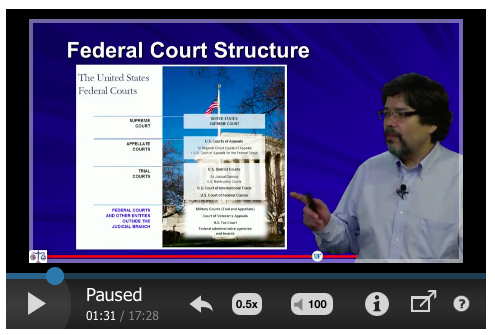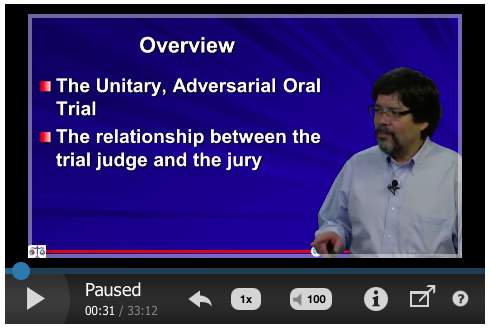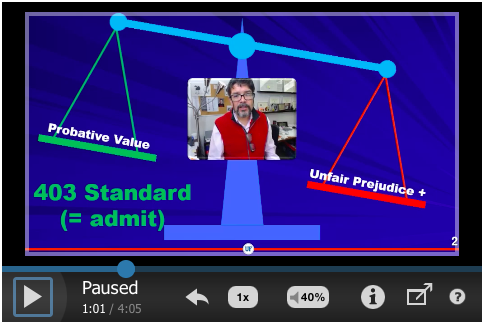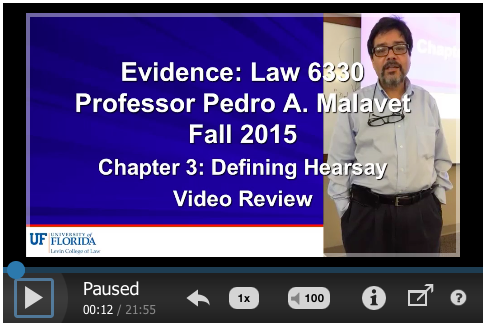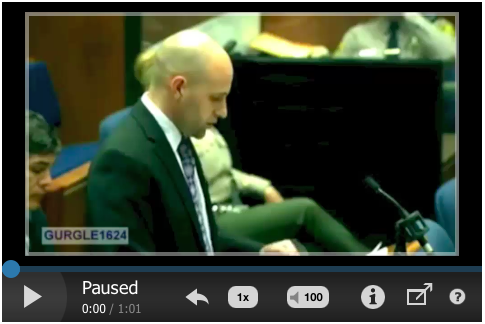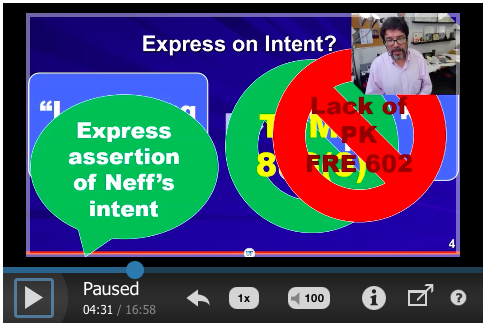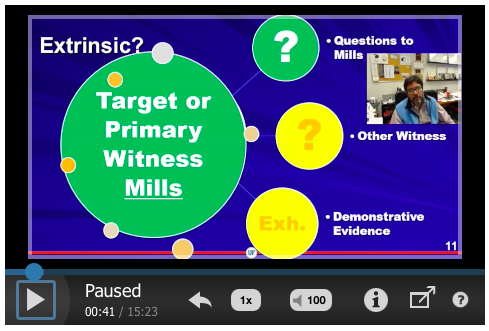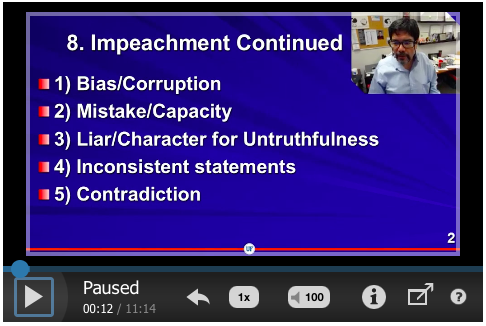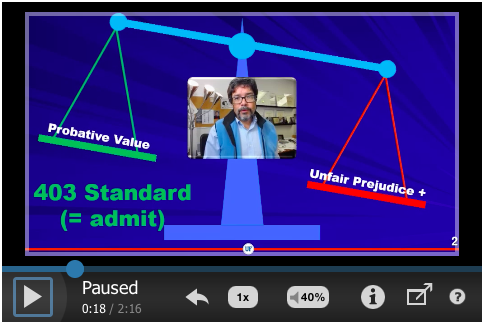Evidence Assignments & Notes
LAW 6330
—Sections RMAL & CMAL
—Class Number 32186 (In Person), 24966 (Online)
Professor Pedro A. Malavet
Spring 2022
Monday, Tuesday & Wednesday
5:30 to 6:45 p.m.
LCOL HH-382 for Class No. 32186
ZOOM for Class No.
24966
This page displays your weekly assignment sheets and provides links to the detailed notes for each class session and topic.
When taught in double 55-minute periods, the sessions will be split into fifty-five-minute segments designated "A," for the first one and "B," for the second. We are scheduled for 26 twice-per-week 120-minute slots that will each be broken down into two 55-minute sessions with a ten-minute break between them, for a net time of instruction of 110 minutes per session day, 220 minutes per week. That should allow us to complete the 2,800 minutes required by ABA standards over our now thirteen-week semester, with about one hour to spare.
When taught in 75-minute sessions, there will be one uninterrupted period per day. We will be scheduled for thirty-nine (39) 75-minute sessions for the semester. That means a total of 2,925 minutes of class are scheduled although we only need to complete 2,800 under ABA standards. The extra 125 minutes will give us some flexbility should there be the need to re-schedule some classes, which may be needed because I may be part of an ABA/AALS site visit team this term, as well as other contingencies.
| ====> | ====> | ====> | Review |
General Comments
Spring 2022. The calendar and lesson plans for the semester will be posted and updated regularly on this page. Only assignments with dates between Tuesday, January 18, 2022, and Monday, April 25, 20221, will reflect updated information.
Printing. Use the "print preview" command to view the precise pages that you wish to print out to refer to the latest reading assignments.
Assignment Sheets. I will issue weekly assignment sheets with specific assignments, by posting them in the website. I will attempt to structure assignments by class session. Students, especially those who sign-up for a particular class, should check with me to make sure what material will be covered. Students must read the assigned pages in the text as well as the pertinent Federal Rules of Evidence in your Supplement. The Notes and Comments in the Rules are extremely helpful and should likewise be included in your reading.
Week One: January 18-19, 2022
- PRIOR To the Start of Classes
- Please visit the course Canvas page and complete:
- The Syllabus Quiz
- The Preferred Prefix (Ms/Mr/Mrs/Other) Survey
- Please visit the course Canvas page and complete:
- Chapter: 1.0 Evidence Law and the System
- Tuesday, January 18, 2022
- Class Participation Sign Up (1) opens
- Session 1
- Class rules, testing, grading and administrative matters.
- See the Syllabus.
- [Click here for my list of "Recommended Readings"]
- Session 1 continued
- 1.1 Introduction:
Why Evidence & The Trial, 1-19
- An introduction to the American Oral Jury Trial
- Pay special attention to What is the Record?, 13-19
- 1.2 Making the Record & Admitting Evidence, 20-30
- 1.1 Introduction:
Why Evidence & The Trial, 1-19
- Session 1 continued
- 1.3 How Evidence is Excluded, and error, 30-43, 43-51
- Consequences of Evidential Error, 43-50
- Obtaining Review of Evidence Points, 50-51
- 1.3 How Evidence is Excluded, and error, 30-43, 43-51
- Session 1
- Chapter: 2.0 Relevance
- Wednesday, January 19, 2022
- Session 2
- 2.1 Defining
Relevance Under the Rules, 53-56, 56-60 (case lecture), 60-62 (Notes), 62-70
- I will lecture on Old Chief at page 56, and
- Problem 2-A. Too Much Wax on the Floor, at page 66, as to how they illustrated the liberality of the Relevance Standard.
- Problem 2-B: Was he going too fast? (p. 67);
- Problem 2-C: Boys on the Bridge (p. 67).
- FRE 401 (Annotated)
- 2.1 Defining
Relevance Under the Rules, 53-56, 56-60 (case lecture), 60-62 (Notes), 62-70
- Session 2 continued
- Problem: 2-D: Flight and Guilt (p. 68) and notes 68-70
- Case: State v. Chapple (p. 71)
- Please be advised that I will show real crime-scene and autopsy photos to illustrate the issues in State v. Chapple.
- This material is quite disturbing and anyone who does not wish to see the images is certainly welcome to look away and even leave the classroom while they are being shown.
- I will again lecture on Old Chief II, pp. 74-78, and the notes at 78-82
to discuss what it stands for under FRE 403.
- Session 2
Videos on US Courts and Trials For this Week
These are from the MOOC The Global Student's Introduction to the Law of the United States that a team of professors at the Levin College of Law published last year. They may help you to see the context of the material that we are covering in very simple terms.
Judges and their Courts in the United States
(Click on the image to launch the video in a new window)
The American Oral Jury Trial and the Rules of Evidence
(Click on the image to launch the video in a new window)
Week Two: January 24-26, 2022
- Monday, January 24, 2022
- Session 3
- Session 3, continued
- Problem 2-H: Completeness: Power rollback caused the crash (pp. 87-88);
- Problem 2-I: Raid on the Cedar Woods Apartment, 91-92
- [Click here to see the notes on 104(a) (Bourjaily) and 104(b) (Huddleston) and "Conjunction" (combined probability) vs. "Coincidence" (overlap of Judge/Jury fact-finding).]
- [Click here to see the notes for conditional relevance in the 7th Edition]
- Chapter: 3.0 Hearsay
- Tuesday, January 25, 2022
- Session 4
- 3.1 Defining Hearsay, 111-117, 121-127, 127-133
- FRE 801(a),(b),(c)
- Problem 3-A: Three see a robbery (pp. 114-15);
- Problem 3-B: Kenworth and Maserati (pp. 116-17)
- Skip: Wright (p. 118-21), I will lecture on it.
- But please READ THE NOTES THAT FOLLOW at 121-125 and the references in the Advisory Committee Notes.
- Session 4, continued
- The Sound of Silence Case: Cain v. George (p. 125-6);
- Indirect Hearsay: United States v. Check, 128-131.
- Check is in some ways a vexing case because of the major differences between what the prosecution says it is doing and what is actually going on.
- Session 4
- Wednesday, January 26, 2022
- Session 5
- Session 5, continued
- Problem 3-E: Whose corn? (p. 136);
- Problem 3-F: I'm from the gas company (and epically stupid) (p. 137);
- If time allows, I will push up the lecture on Eagle's Bar and Grill, but I think it is more likely that I will have to leave it for next week)
- Preview: 3.3 Defining [NOT?] Hearsay, 137-151
- Problem 3-G: Eagle's Bar & Grill, (pp. 138-39), I will lecture on.
- Easy: Trademarks on vehicles and products that you see every day
- Complicated: Idiosyncratic marks, which I prefer to treat as a subset of verbal acts of ownership and identification of objects/things.
- Hearsay Preview/Review Video
- Repeated Hearsay Objections:
- Video: Inferred, Implied vs. Express assertion of State of Mind:
Nonhearsay vs. FRE 803
Week Three: January 31-February 2, 2022
- Chapter: 3.0 Hearsay (cont.)
- Monday, January 31, 2022
- Session 6
- Started with a review of all problems from session 5 because of the sound problems.
- 3.3 Defining [NOT?] Hearsay, 137-151
- Problem 3-G: Eagle's Bar & Grill, (pp. 138-39), I will lecture on.
- Easy: Trademarks on vehicles and products that you see every day
- Complicated: Idiosyncratic marks, which I prefer to treat as a subset of verbal acts of ownership and identification of objects/things.
- Problem 3-H: Anna Sofer's Will (pp.140-41);
- Is Anna saying that Ira is a jerk or acting out her anger at him?
- Problem 3-I: A papier-mache man (pp. 141-142)
- How would someone who does not live there know what a room looks like?
- Session 6, continued (pushed to Tuesday)
- Session 6
- Tuesday, February 1, 2022
- Session 7
- 3.4 Defining Hearsay, 151-158, 158-161
- Case: Singer (p. 146)
- Problem 3-J: My Husband is in Denver (p. 148);
- Problem 3-L: King Air (p. 150)
- Case: Pacelli (pp. 151-53)
- I will lecture on OLD Problem 3-M, which has been superseded by Note 2: I didn't tell them anything about you (p. 154)
- Note also the discussion of questions and commands.
- Case: Betts (p. 158-60) to be finished Wednesday
- Session 7, moved to Wednesday
- 3.5 Hearsay Quiz (pp. 161-64): Test your Skills
- I will not be able to discuss every one of these in class, but will try to cover as many as possible and try to address any specific questions about some of the questions that the class finds especially difficult.
- Session 7
- Chapter: 6.0 Competency of Witnesses
- Wednesday, February 2, 2022
- Session 8
- Case: Pacelli (p. 151) Reviewed and Finished
- I will lecture on OLD Problem 3-M, which has been superseded by Note 2: I didn't tell them anything about you (p. 154)
- Note also de discussion of questions and commands.
- Case: Betts (p. 158-60)
- Case: Pacelli (p. 151) Reviewed and Finished
- Session 8, continued
- 3.5 Hearsay Quiz (p. 161): Test your Skills
- I will not be able to discuss every one of these in class, but will try to cover as many as possible and try to address any specific questions about some of the questions that the class finds especially difficult.
- Session 8
Week Four: February 7-9, 2022
- Monday, February 7, 2022
- Session 9
- 6.1.a. Competency under the Rules, 489-500, 505-504
(two volunteers for each case)- Case: U.S. v. Lightly (Criminally insane witness?, p. 492);
- Case: U.S. v. Fowler (Oath/Affirmation, p. 495);
- Case: Rickets v. Delaware (Child witness, p. 497)
- 6.1.b. Special Cases (Lecture, 500-504)
- Dead Person's Statutes
- Judge as Witness
- Lawyer as Witness
- 6.1.a. Competency under the Rules, 489-500, 505-504
- Session 9, continued
- 6.2. Jury Mistake/Misconduct, 504-510,
- Problem 6-A: Outside Influence (p. 505)
- Case: Tanner v. U.S. (pp. 505-510), FRE 606(b).
- We may get started on Tanner, but most of the discussion will take place on Tuesday.
- Session 9
- Tuesday, February 8, 2022
- Session 10
- 6.3. Jury Mistake or Misconduct Case and Problems, 505-511, 511-512
- Case: Tanner v. U.S. (pp. 505-510), FRE 606(b).
- Problems, 511-512
- Problem 6-B. Refusal to Take the Stand
- Problem 6-C. The Jury View
- Problem 6-D. The Bomber
- Problem 6-E. The $800,000 Jury Error
- Flipped a Coin?
- Constitutional Challenges, 512-516
- NEW Problem 6-F. "Women Drivers," 516
- This is a new problem to illustrate Peña-Rodríguez and possible expansion to cover gender-bias.
- NEW Problem 6-F. "Women Drivers," 516
- Wednesday, February 9, 2022
- Session 11
- 6.4. Constitutional Challenges to Juror Misconduct, 512-516
- What about juror bias (such as racism)?
- Literature on Implicit Bias in Courts
- Literature on Actual Bias and its Significance
- Jury Instructions on Actual and Implicit Bias
- Peña-Rodríguez v. Colorado, 580 U.S. ___(S.Ct. March 6, 2017)
- Reading is the slip opinion that is linked above.
- SCOTUS, 5-3 rules that the 606(b) jury inquiry privilege must give way to the 6th Amendment right to an impartial jury: "A constitutional rule that racial bias in the justice system must be addressed —including, in some instances, after the verdict has been entered— is necessary to prevent a systemic loss of confidence in jury verdicts, a confidence that is a central premise of the Sixth Amendment trial right."
- Certiorari had been granted by SCOTUS in April 2016 in
- Peña-Rodríguez v. Colorado to resolve the question whether racist anti-Mexican (really anti-Latinx) expressions by juror could be proved with fellow juror testimony to impeach the verdict.
- SCOTUS No. 15-606
- Opinion below: 350 P.3d 287 (Colorado Supreme Ct. 2015) (4-3 decision. Dissenting three judges cited Villar.)
- Raises FRE 606(b), 6th Amendment, Due Process and possibly Equal Protection questions.
- Oral argument was heard during the afternoon session of Monday, October 11, 2016, which was the first day of arguments of the second week of the term because Monday the 10th was a holiday.
- Transcript of Oral Argument: [Click Here to Launch in a New Window]
- Recording of Oral Argument: [Click Here to Launch in a New Window]
- It is often helpful to open the transcript while listening to the recording in order to identify who is speaking.
- Peña-Rodríguez v. Colorado to resolve the question whether racist anti-Mexican (really anti-Latinx) expressions by juror could be proved with fellow juror testimony to impeach the verdict.
- What about juror bias (such as racism)?
- 6.4. Constitutional Challenges to Juror Misconduct, 512-516
Week Five: February 14-16, 2022
- Chapter: 7.0 Direct and Cross-Examination
- Monday, February 14, 2022
- Session 12
- 7.1 Direct Examination, Refreshing Recollection and Woodshedding, 517-25
- Simulation of witness being called,
- sworn and giving testimony based on personal knowledge as well as authenticating demonstrative evidence.
- Refreshing recollection during trial testimony
- Refreshing recollection prior to testimony: Woodshedding, 524-25
- Session 12 continued
- 7.2. Cross-Examination, Excluding Witnesses, 525-534
- Cross-Examination, 525-28
- Excluding Witnesses: The Rule on Witnesses, FRE 615, 529-34
- Case: Susanna and the Elders, pp. 529-31
- Problem 7-A: Daily Transcripts (p. 531);
- What is the "pig rule"?
- Cost of Daily Transcripts Update
- Inaccuracy in Transcripts
- A recent study found, as reported by Vice News:
- As a standard, court reporters are required to achieve at least 95 percent accuracy in their transcriptions before they are certified. They are tested on speed, punctuation, spelling, and specific medical and legal jargon in Standard American English (SAE).
- For the study, called “Testifying while black: An experimental study of court reporter accuracy in transcription of African American English,” researchers tested already-certified court reporters based in Philadelphia by asking them each to transcribe 83 sentences in everyday AAE. The recordings featured nine different native AAE speakers recruited from West Philadelphia, North Philadelphia, Jersey City, and Harlem, who each have had contact with the criminal justice system. On average, the 27 court reporters who took part were only able to record AAE speakers with 82.9 percent accuracy.
- https://www.vice.com/en/article/ywynzj/court-reporters-write-down-black-testimonies-wrong-study
- The article may be found here (you may need to authenticate using the University of Florida Libraries subscription).
- A recent study found, as reported by Vice News:
- Exclussions from the Rule on Witnesses
- Old Problem 7-B has been removed and turned into notes so I will simply lecture on the matter.
- Session 12
- A Preview of Impleachment
- Since Chapter 7 is relatively short, I should have time to lecture on the basics of impeachment at the end of the class.
- Chapter 8.0 Impeachment
- Tuesday, February 15, 2022
- Session 13
- 8.1. Impeachment Generally, 535-550
- Impeachment: Sensory and Mental Capacity &
Character for "Truth and Veracity": Nonconviction Misconduct, 548-559 - Sensory and Mental Capacity, 548-50
- The Innocence Project
- Note the many problems with eywitness identification that produce wrongful convictions
- A cautionary tale:
- The Innocence Project
- The Rape of Jennifer Thompson and the Ordeal [by Innocence] of Ronald Cotton
(CAUTION, strong language and violent content).
- Session 13, continued
- Nonconviction Misconduct, 550-559
- FRE 608
- Case: United States v. Manske, pp. 553-56
- Manske replaced Murphy v. Bonanno
- This section may be pushed to Wednesday
- Character for "Truth and Veracity": Proving Prior Convictions, 559-572
- Problem 8-B: "Hit the Deck" (p. 563)
- Case: Lipscomb (Notes & Lecture)
- Lipscomb has been removed as a case study, but it is discussed in the notes following Problem 8-B as it relates to the Gordon Factors.
- Problem 8-C: A History of Lying (pp. 567-8);
- Problem 8-B: "Hit the Deck" (p. 563)
- Wednesday, February 16, 2022
- Session 14
- If not covered on Tuesday.
- Character for "Truth and Veracity": Proving Prior Convictions, 559-572
- Problem 8-B: "Hit the Deck" (p. 563)
- Case: Lipscomb (Notes & Lecture)
- Lipscomb has been removed as a case study, but it is discussed in the notes following Problem 8-B as it relates to the Gordon Factors.
- Problem 8-C: A History of Lying (pp. 567-8);
- Problem 8-B: "Hit the Deck" (p. 563)
- Session 14
- 8.2.Prior Convictions, 570-577
- LECTURE: Problem 8-D: Faker or Thug? 609(a) or 608(b)? (570-1)
- Lecture. This is a special problem to discuss the possible conflict between FRE 608(b) and 609
- Old Problem 8-D: Five-time loser was superseded, but it illustrates a special problem with FRE 609(b) that I will lecture on in class.
- Case: Luce v. United States (573-7)
- Defendant moved in limine to preclude impeachment at trial using his prior conviction for possession of a controlled substance. When this motion was denied, defendant chose not to testify. He was convicted and appealed. On appeal, the SCOTUS ruled that by failing to take the witness stand, he had waived his right to appeal the trial court's 609(a) ruling.
- Note also that in footnote 4 at page 574 of the Luce text, the SCOTUS specifically approves of the practice of filing and ruling upon motions in limine.
- Character Witnesses on Truth Telling, 577-8;
- Prior Inconsistent Statements, 578-586
- This material is likely to be pushed to the next week.
- Fourth, Fifth & Sixth Amendment Cases, 586-96
- Prior Silence Offered to Impeach, 594-6
- Case: Jenkins v. Anderson, now reduced to notes (prearrest silence used to impeach defendant)
- I will lecture on Jenkins v. Anderson which is now just a note
- Contradiction, 596-610
- LECTURE: Constitutional Issues, this material will be reduced to lecture in order to move on to chapter 9
- Mapp v. Ohio Video (Courtesy of Prof. Wolf)
- The Comment/Perspective Note at pages 616-7 in the casebook summarizes the constitutional issues succinctly and accurately.
- Case: United States v. Havens, 602-7
(suppressed evidence used to contradict). - Repairing Credibility, 610-23
- Forbidden Attacks, 623-4
- FRE 610 Religious Beliefs
Week Six: February 21-23, 2022
- Monday, February 21, 2022
- Session 15
- 8.2.Prior Convictions, 570-577
- LECTURE: Problem 8-D: Faker or Thug? 609(a) or 608(b)? (570-1)
- Lecture. This is a special problem to discuss the possible conflict between FRE 608(b) and 609
- Old Problem 8-D: Five-time loser was superseded, but it illustrates a special problem with FRE 609(b) that I will lecture on in class.
- LECTURE: Problem 8-D: Faker or Thug? 609(a) or 608(b)? (570-1)
- Case: Luce v. United States (573-7)
- Defendant moved in limine to preclude impeachment at trial using his prior conviction for possession of a controlled substance. When this motion was denied, defendant chose not to testify. He was convicted and appealed. On appeal, the SCOTUS ruled that by failing to take the witness stand, he had waived his right to appeal the trial court's 609(a) ruling.
- Note also that in footnote 4 at page 579, the SCOTUS specifically approves of the practice of filing and ruling upon motions in limine.
- Character Witnesses on Truth Telling, 577-8;
- A special challenge: Expert Opinion on Credibility,
- The Innocence Project on Eyewitness Misidentification
- Prior Inconsistent Statements, 578-586
- 8.2.Prior Convictions, 570-577
- Session 15, continued
- Fourth, Fifth & Sixth Amendment Cases, 586-96
- Prior Silence Offered to Impeach, 594-6
- Case: Jenkins v. Anderson, now reduced to notes (prearrest silence used to impeach defendant)
- I will lecture on Jenkins v. Anderson which is now just a note
- Contradiction, 596-610
- LECTURE: Constitutional Issues, this material will be reduced to lecture in order to move on to chapter 9
- Mapp v. Ohio Video (Courtesy of Prof. Wolf)
- The Comment/Perspective Note at pages 616-7 in the casebook summarizes the constitutional issues succinctly and accurately.
- Case: United States v. Havens, 602-7
(suppressed evidence used to contradict). - Repairing Credibility, 610-23
- Forbidden Attacks, 623-4
- FRE 610 Religious Beliefs
- Chapter: 9.0 Opinion and Expert Testimony
- Tuesday, February 22, 2022
- Session 16
- 9.1.a Lay Opinion Testimony, 625-52
- Problem 9-A: "It was my impression" (p. 628);
- Problem 9-B: The Watchful Neighbor (p. 630-1)
- (BONUS: the smell of marijuana!).
- This problem has so many scenarios that we will continue to discuss it during the second hour.
- 9.1.a Lay Opinion Testimony, 625-52
- Session 16, continued
- 9.1.b Experts: Meeting The Elements of FRE 702, pp. 633-52
- Problem 9-C: "They Saw it The Same Way I Did" (p. 639-40);
- LECTURE on OLD Problem 9-D: .24% Alcohol has been deleted, but it relates well to Crawford
- The extended notes in this section develop the use of experts and how they are used at trial. It is a prelude to the discussion of Daubert and Kumho Tire.
- Session 16
- Wednesday, February 23, 2022
- Session 17
- 9.2.a. Scientific Evidence-1: Daubert, 652-667
- Case: Daubert (p. 655)
- 9.2.b. Scientific Evidence-2: Kumho Tire, 668-681
- 9.2.c. A note on Florida's complicated attempt to decide between Frye and Daubert
- On February 16, 2017 the Court rejected the amendments
- The Florida Supreme court ruled that the standard to be applied in this area was a matter of procedure within its constitutional discretion and declined to adopt Daubert.
- A divided court continued to apply Frye and expressly rejected Daubert in 2018
- And then, on May 23, 2019, the court, with new members, reversed itself.
- While the matter is "procedural" and thus within the authority of the Supreme Court, the court has the discretion to adopt the legislative amendments as the new rules, and did so.
- In Re Amendments to the Florida Evidence Code 2019
- On February 16, 2017 the Court rejected the amendments
- 9.2.d. Modern Science in the Courtroom, 681-695
- I recommend this material simply as background reading for our discussion of the forensic evidence and confrontation cases.
- 9.2.a. Scientific Evidence-1: Daubert, 652-667
- Session 17
Week Seven: February 28-March 2, 2022
- Chapter: 4.0 Hearsay Exemptions and Exceptions
- Hearsay Review Video
- Repeated Hearsay Objections:
- Monday, February 28, 2022
- Session 18
- 4.01.a. Hearsay: Prior Inconsistent Statement, 165-176
- Please pay special attention to the new introductory note addressing the Crawford doctrine.
- FRE 801(d)(1)(A)
- Case: State v. Smith (p. 167-71)
- Problem 4-A: "I Got Amnesia" (pp. 172-4)
- Session 18, continued
- 4.01.b. Hearsay: Prior Consistent Statement, 176-83
- FRE 801(d)(1)(B)
- Problem 4-B: He Thinks I 'm His Wife" (pp. 180-1)
This problem is based on Tome v. U. S. which was found in prior editions- Manufacturing and promoting false, rather than investigating and prosecuting true, claims of child abuse is unfortunately a real danger here. For a disturbing case, see the McMartin Preschool investigation and prosecution. No physical evidence of abuse, and improper methods led to baseless claims.
- McMartin Preschool Case
- Problem 4-B: He Thinks I 'm His Wife" (pp. 180-1)
- 4.02.b Statements of Identification, pp. 183-189
FRE 801(d)(1)(C)- State v. Motta, pp. 184-6
- Session 18
- Tuesday, March 1, 2022
- Session 19
- 4.02.b Statements of Identification, pp. 183-189
FRE 801(d)(1)(C) (If not covered on Monday)- State v. Motta, pp. 184-6
- 4.02 Admissions by a Party Opponent, 189-204
- FRE 801(d)(2)(A)
- Problem 4-C: Fire in the warehouse (p. 191)
- Problem 4-D: An Encounter Gone Bad (pp. 195-6)
- Individual Admissions and co-authors:
Case: Bruton v. U.S. (pp. 197-200)
- 4.02.b Statements of Identification, pp. 183-189
- Session 19
- Wednesday, March 2, 2022
- Session 20
March 7-11, 2022 is our 2022 Spring Break
Week Eight: March 14-16, 2022
- Monday, March 14, 2022
- Video: Admissions and Crawford Preview
- Tuesday, March 15, 2022
- Session 22, finishing the previous unit if needed
- Session 22
- 4.06 Hearsay: State of Mind FRE 803(3), 254-75
- Problem 4-K: He says he'll kill me (p. 258)
- PREVIEW of Hillmon and Pheaster
- Wednesday, March 16, 2022
- Session 23
- 4.06 Hearsay: State of Mind FRE 803(3), 254-75, continued
- Case: Mutual Life v. Hillmon (pp. 262-5)
- Most people thought that Hillmon was pretty extreme and that it was rejected by the FRE, and then came Pheaster.
- Case: U.S. v. Pheaster (pp. 265-9)
- Problem 4-L: Fright Points the Finger (p. 273).
- Video: FRE 803(3) Parts A and B
Week Nine: March 21-23, 2022
- Chapter 4.0 Hearsay Exemptions and Exceptions
- Monday, March 21, 2022
- Session 24
- Finishing up with
- Statements for Medical Treatment, 275-7
- 4.07 Hearsay: Declarant "Unavailable"? 328-337
FRE 804(a)- Case: Barber v. Page (p. 332)
- Is it possible to be "unavailable" under FRE 804 and "available for cross-examination" for Confrontation Clause purposes?
- Also, what is the meaning of the entitlement to cross-examine witnesses, and can it only be satisfied at trial?
- Problem 4-O: The government let her go (pp. 335-6)
- Session 24
- Tuesday, March 22, 2022
- Session 25
- 4.07.b. Hearsay: Forfeiture Doctrine, 364-372
- Session 25
- Case Notes: Giles v. California, pp. 364-69
- (we will discuss the full opinion which is posted to the Supplemental Reading folder in the FILES tab of the CANVAS page).
- Problem 4-Q. "If You Want to Stay Healthy" (p. 371)
- I can think of no better illustration of the seriousness of the effect of the Sixth Amendment Confrontation Clause than Giles v. California and its application of the constitutional forfeiture doctrine.
- Preview: the Crawford Doctrine.
- 4.08.a. G. Impact of the Confrontation Clause, 383-403
- OLD CASE: Ohio v. Roberts (this will be the introductory lecture; time-permitting, I will start it on Monday)
- Ohio v. Roberts has been overruled by Crawford and Davis as the constitutional standard. But, read these notes and the authors' discussion of Roberts at pages 384-6 to see if it remains a part of the rules. The background is important, but we will focus on Crawford.
- OLD CASE: Ohio v. Roberts (this will be the introductory lecture; time-permitting, I will start it on Monday)
- 4.08.a. G. Impact of the Confrontation Clause, 383-403
- Wednesday, March 23, 2022
- Session 26
- It is highly-unlikely that we will finish all three major cases in one session, but I want you to see the "big picture" of the Crawford trilogy and we will have continued discussion of it into the next week.
- 4.08.a.1. G. Impact of the Confrontation Clause, 383-403
- OLD CASE: Ohio v. Roberts (this will be the introductory lecture if I am unable to cover it on Monday)
- Ohio v. Roberts has been overruled by Crawford and Davis as the constitutional standard. But, read these notes and the authors' discussion of Roberts at pages 384-6 to see if it remains a part of the rules. The background is important, but we will focus on Crawford.
- OLD CASE: Ohio v. Roberts (this will be the introductory lecture if I am unable to cover it on Monday)
- 4.08.a.2. G. Crawford and the "Testimonial" Approach, 387-403
- 4.08.b. Applying Crawford: The Emergency Doctrine:
- Davis v. Washington, 404-412,
- It is likely that our discussion of Davis will spill over into our second hour.
- 4.08.b. Applying Crawford: The Emergency Doctrine:
- Davis v. Washington, 404-412, continued if necessary.
- 4.08.c. The "totality of the circumstances" standard: Michigan v. Bryant, Notes at pages 411-12
- I have extensive notes on the Bryant opinion here. The new interpretation the Sixth Amendment to bar the use of “Testimonial” hearsay absent a showing of unavailability and a prior opportunity to cross-examine, and they all buy into the Emergency Doctrine. They disagree on what CLASSIFIES as “Testimonial” or as an “Ongoing Emergency”. Normal judicial discretion differences. But they agree on the categories that represent a total abandonment of Ohio v. Roberts as a constitutional standard for applying the Confrontation Clause. Quite remarkable.
- Full Opinion wi(The full opinion is posted to the Canvas page, and I will use the full opinion to discuss the analysis as you should have included it in your motions as the student-panel and I discuss the details of the case and its ruling).
- The full opinion is already posted to the course Canvas page: Files->Supplemental Reading
- We will discuss the Full Opinion.
- Motion in Limine Discussion built-into the class.
- 4.08.d. Applying Crawford:
The Cross-Examination Factor, 412-20
- Session 26
Week Ten: March 28-30, 2022
- Monday, March 28, 2022
- Session 27
- 4.08.a.1. G. Impact of the Confrontation Clause, 383-403
- OLD CASE: Ohio v. Roberts (this will be the introductory lecture if I am unable to cover it on Monday)
- Ohio v. Roberts has been overruled by Crawford and Davis as the constitutional standard. But, read these notes and the authors' discussion of Roberts at pages 384-6 to see if it remains a part of the rules. The background is important, but we will focus on Crawford.
- OLD CASE: Ohio v. Roberts (this will be the introductory lecture if I am unable to cover it on Monday)
- 4.08.a.2. G. Crawford and the "Testimonial" Approach, 387-403
- 4.08.b. Applying Crawford: The Emergency Doctrine:
- Davis v. Washington, 404-412,
- It is likely that our discussion of Davis will spill over into our second hour.
- 4.08.a.1. G. Impact of the Confrontation Clause, 383-403
- Session 27 (Continuing the Crawford doctrine focusing on Davis and Mich. v Bryant)
- 4.08.b. Applying Crawford: The Emergency Doctrine:
- Davis v. Washington, 404-412, continued if necessary.
- 4.08.c. The "totality of the circumstances" standard: Michigan v. Bryant, Notes at pages 411-12
- I have extensive notes on the Bryant opinion here. The new interpretation the Sixth Amendment to bar the use of “Testimonial” hearsay absent a showing of unavailability and a prior opportunity to cross-examine, and they all buy into the Emergency Doctrine. They disagree on what CLASSIFIES as “Testimonial” or as an “Ongoing Emergency”. Normal judicial discretion differences. But they agree on the categories that represent a total abandonment of Ohio v. Roberts as a constitutional standard for applying the Confrontation Clause. Quite remarkable.
- Full Opinion wi(The full opinion is posted to the Canvas page, and I will use the full opinion to discuss the analysis as you should have included it in your motions as the student-panel and I discuss the details of the case and its ruling).
- The full opinion is already posted to the course Canvas page: Files->Supplemental Reading
- We will discuss the Full Opinion.
- Motion in Limine Discussion built-into the class.
- 4.08.d. Applying Crawford:
The Cross-Examination Factor, 412-20
- 4.08.b. Applying Crawford: The Emergency Doctrine:
- Session 27
- Tuesday, March 29, 2022
- Session 28
- Wednesday, March 30, 2022
- Session 29
- We will spend these two sessions on the Melendez-Diaz trilogy and on the specifics of the practical project motion in limine.
- Scientific Evidence and the Sixth Amendment
- Case Readings for both hours will include:
- Edited versions of Meléndez and Bullcoming that are already posted to the course Canvas pages under Supplemental Readings and the full opinion in Williams v. Illinois that is also there.
- 4.11. Hearsay: Public Records and Government Declarants in Criminal Cases: pp. 304-5, 313-322
FRE 803(8).- For decades, Public Records, primarily those related to forensic results, would be used in criminal prosecutions as a substitute for the testimony of a number of government experts.
- As long as this was a legislative prerogative, the rules determined the admissibility and were of course subject to amendment as provided by federal or state law.
- Crawford changed that by imposing a confrontation clause limitation in criminal prosecutions. But three mixed cases have left matters a bit confused.
- THREE CASES WITH PERHAPS MIXED RESULTS:
Melendez, Bullcoming and Williams.- First came Melendez Diaz v. Mass., and then things got messy.
- In this session I will spend time going over all three of the cases, but most of the time will be spent on Meléndez-Díaz and the problem. I will then focus on more extensively on Williams on the second session.
- A note on Bullcoming v. New Mexico (the June 2011 decision) (when Bryant was resolved, the two newest justices were on the court, but only Justice Sotomayor could vote; Justice Kagan recused herself because she had signed an amicus brief in support of the petitioner State of Michigan when she was Solicitor General).
- Williams v. Illinois, the DNA case made things very messy, but it is unclear how so.
- First came Melendez Diaz v. Mass., and then things got messy.
- Case Readings for both hours will include:
- Session 28
- Melendez Diaz v. Mass., applying Crawford to forensic science in the courtroom
- Edited text of the opinion on Canvas
- Bullcoming v. New Mexico (the June 2011 decision),
- Edited text of the opinion on Canvas
- Melendez Diaz v. Mass., applying Crawford to forensic science in the courtroom
- Session 29
- Finish Bulcoming v. New Mexico, likely, then
- Williams v. Illinois,
- Full text of the opinion on Canvas
- Problem 4-N: "You Can't Offer the Police Report", pp. 320-1
- 803(8) in Criminal Cases notes.
- Session 29
Scientific Evidence Standard and Forensics and the Confrontation Clause, Melendez, Bullcoming and Williams
Melendez involved chemical analysis of drugs.
Bullcoming involved blood-alcohol lab reports in a drunk driving prosecution. The majority, 5-4, applied Crawford to label them "testimonial" and thus to require a result similar to Melendez-Diaz.
Williams involved the use of forensic reports of DNA analysis prepared at an outside laboratory (independent relative to law-enforcement) by a state technician who testified at trial and conducted separate testing of her own. This was a bench trial, and the court emphasized that the judge, unlike a jury, would not be confused about the proper use of the evidence. The plurality opinion by Justice Alito announced the result, but only garnered four full votes (his own and that of Chief Justice Roberts and Justices Kennedy and Breyer), Justice Breyer issued a separate opinion concurring in the ruling (but indicating he would have wanted additional briefing and reargument during the next term); Justice Thomas issued a separate opinion concurring in the judgment but concluding that the private laboratory report was too "informal" to be considered "testimonial"; Justice Kagan issued a lengthy dissent joined by Justices Scalia, Ginsburg and Sotomayor.
Although the passage of time and the use of the cases by the lower courts has given us some clarity, the court has made a bit of a mess of the area of laboratory reports with Williams. But the concerns are matters of trial tactics and the use of government expert witnesses in criminal trials.
However, as I noted above, Michigan v. Bryant shows you the primary effect and current status of the Crawford doctrine: All justices in the current court agree with the new interpretation the Sixth Amendment to bar the use of “Testimonial” hearsay absent a showing of unavailability and a prior opportunity to cross-examine, and they all buy into the Emergency Doctrine. They disagree on what CLASSIFIES as “Testimonial” or as an “Ongoing Emergency”. Normal judicial discretion differences. But they agree on the categories that represent a total abandonment of Ohio v. Roberts as a constitutional standard for applying the Confrontation Clause. Quite remarkable.
JUNK SCIENCE IN THE COURTROOM
Justice Scalia made repeated references in Melendez-Diaz, to the National Academy of Sciences 2009 report finding that much of the supposed forensic "science" evidence admitted in criminal trials was deeply flawed and was more like JUNK science. The Academy called for changes to how so-called scientific evidence is admitted in criminal trials.
Click here to see that report.
On September 20, 2016, the President's Council of Advisors on Science and Technology issued a follow up to that report, decrying the use of unreliable forensics in court proceedings and making recommendations for change.
The report can no longer be found in the White House website, but here is a PDF version of it.
Click here to see that report.
Week Eleven: April 4-6, 2022
- Monday, April 4, 2022
- Session 30
- Problem 5-A: Fight in the Red Dog Saloon (Part 1), (p. 423)
- Problem 5-B: Red Dog Saloon (Part 2), (p. 425)
- 5.1.b. Proving Character, 427-34
- Problem 5-C: Red Dog Saloon (Part 3) (pp. 427-8)
- Problem 5-D: What Price Truth? (p. 430)
- 5.1.c Character as Element of the, Charge, Claim or Offense, 432-5
- OLD Problem 5-E: "She's a Known Thief" has been edited out so I will lecture on it.
- This part of the readings is mostly to warn you not to overuse FRE 405(b)
- Problem 5-E: Drug Sale of Scam? (intent, p. 437)
- Problem 5-E is a perfect example of why I love my job!
- Tuesday, April 5, 2022
- Session 31
- 5.2 Prior Acts to show ... (in general, intent, plan), 435-46
- Problem 5-F: "He Came Running in All Hunched Over" (modus operandi, p. 439)
- We will focus on the first two problems and I will lecture on the two new problems from the 9th edition
- NEW Problem 5-G: Was it a Crime or Just a Misunderstanding? (plan or design, p. 441)
- Lecture
- NEW Problem 5-H: "It Was Just a Tragic Accident," (other purposes, p. 443)
- Lecture
- OLD Problem 5-H: The Undercover Cop Trick (plan, design, Edited out or 9th edition) OLDER Problem 5-H: The Corrupt Judge (plan, design) OLD Problem 5-I: It Was An Accident (other purposes)
- Problem 5-F: "He Came Running in All Hunched Over" (modus operandi, p. 439)
- 5.2.b. Proving Prior [Other] Acts, 446-50
- Problem 5-I: I didn't know they were stolen (proving prior acts, p. 447)
- This problem is based on Huddleston and explains the standard for FRE 104(b)
- Problem 5-I: I didn't know they were stolen (proving prior acts, p. 447)
- 5.2 Prior Acts to show ... (in general, intent, plan), 435-46
- Wednesday, April 6, 2022
- Session 32
- Extended Discussion & Questions and Answers
- We will finish up with Conditional Relevance and proving prior conduct.
- I will then spend time going over the Motion In Limine and what my expectations are as well as what I want you to get out of the project for practical purposes as well as for the examination.
- Extended Discussion & Questions and Answers
- Session 32
Week Twelve: April 11-13, 2022
- Monday, April 11, 20212
- Session 33
- Character of Alleged victim,
- 5.3 Character of Alleged Victim in Sex Offense Cases, 450-5
- Initial discussion of why FRE 412 exists and how it is uniquely directed at Judges who kept getting it wrong. I will at least go over the history of character evidence used against victims in sexual assault cases and the purpose of FRE 412. Depending on how much time we spend on the motion, I will defer this problem to Monday.
- Problem 5-J: Ordeal of Leslie or Fred (p. 451)
- Video: "Standard" v. "Reverse" 403 Balancing
- I will push the rest of the discussion of FRE 412 and 413 to next week.
- Problem 5-K: Acting Out on the Assembly Line (p. 454)
- a sexual harassment civil case
- 5.3 Character of Alleged Victim in Sex Offense Cases, 450-5
- 5.3.b. Character of Defendant in Sex Offense Cases, 455-60
- Problem 5-L: "I Told Him to Stop" (p. 457-8)
- Character of Alleged victim,
- Session 33
- Tuesday, April 12, 2022
- Session 34
- Chapter: 5.0 Relevance Revisited (continued)
- 5.4 Habit and Routine Practice, 460-6
- Problem 5-M: Death on the Highway (p. 461)
- Problem 5-N: The Burning Sofa (p. 462)
- Problem 5-O: Was he Served? (p. 464)
- Wednesday, April 13, 2022
- Session 35
- Case: Tuer v. McDonald (p. 467)
- This case represents a very extreme application of the rule.
- Session 35
Week Thirteen: April 18-20, 2022
We will finish any material left over from the readings from the previous week this week as needed.
I will then go back over hearsay basics and review the Crawford line of cases using the court's most recent case: Hemphill v. New York (January 20, 2022). The full text of this opinion is in the Supplemental Reading folder of the Canvas page.
I will also provide feedback on your Motions In Limine and we will also have a general review of the course.
- Monday, April 18, 2022
- Session 36
- Finishing any material not covered during the previous week.
- 5.5.b. Plea-Bargaining Negotiations, etc., 478-85
- General feedback on the motions in limine: strenghts, weaknesses, best practices for motions contrasted with best practices for the exam.
- Session 36
- Tuesday, April 19, 2022
- Session 37
- Review of the Crawford Doctrine and it's state after Hemphill v. New York (January 20, 2022).
- Text of the slip opinion in the Supplemental Reading folder on Canvas.
- Review of the Crawford Doctrine and it's state after Hemphill v. New York (January 20, 2022).
- Session 37
- Wednesday, April 20, 2022
- Session 38
- General course review
- Session 38
Week Fourteen: April 25, 2022
Because we have consistently used 75 minutes per session and will thus complete our 2800 minutes the week prior, with time to spare, and since we have not needed to make up any sessions, this session is unnecessary. I will instead have ZOOM office hours.
- Monday, April 25, 2022
- Session 39
- Not needed
- CONVERTED TO ZOOM OFFICE HOURS
- To discuss you motions in general and to answer questions
- No Reading Period Office Hours
- Our exam is scheduled for Monday, May 9, 2022. Online exams are now scheduled for the mornings so that the Office of Students Affairs may have time to resolve any problems with the exams of the day.
Week Fifteen: Not Likely to be Needed in Spring 2022
This week will not be needed.
Not Updated For Spring 2022 Below This Line
Review Session: I will use the additional time as office hours and a review session.
Note that I will NOT answer substantive questions after the review session and the expanded office hours during the reading period.
This is the End!
